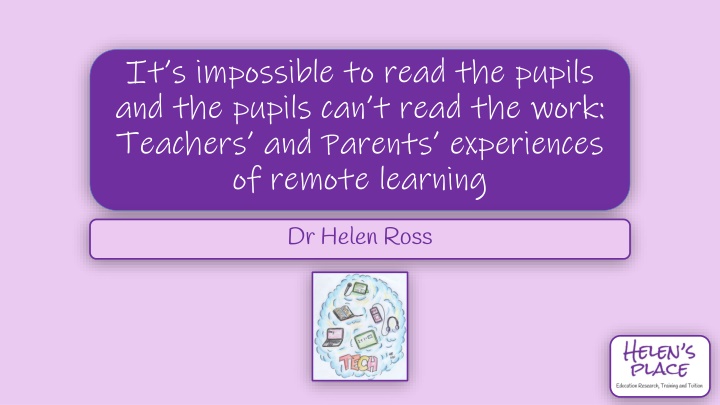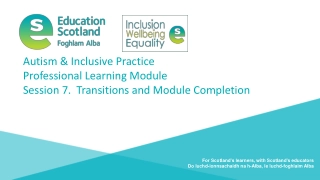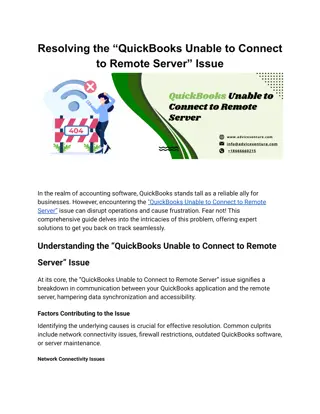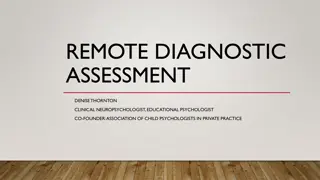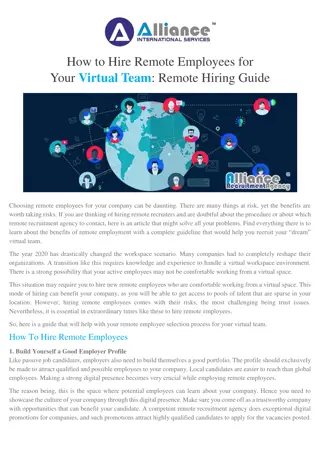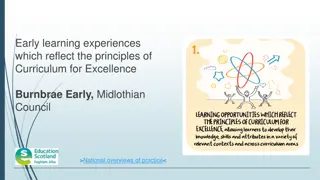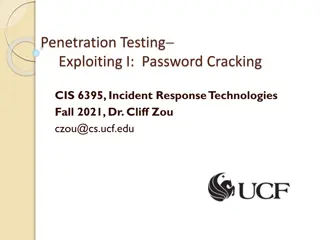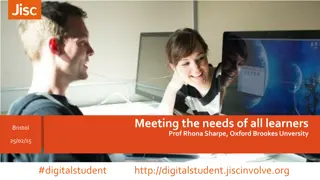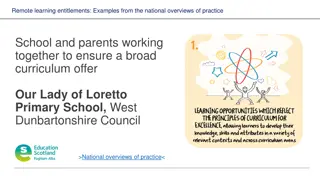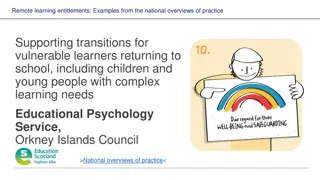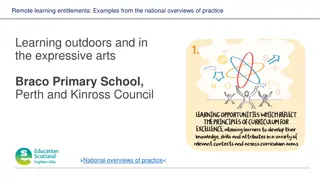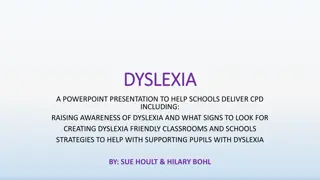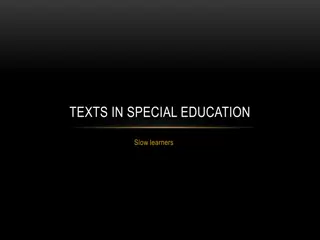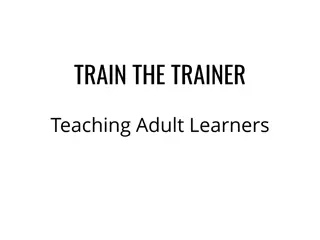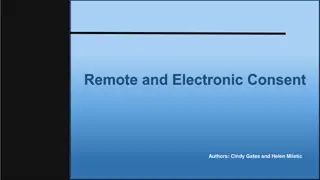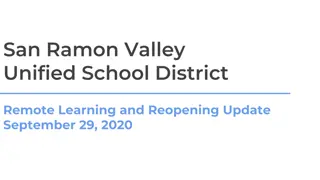Challenges of Remote Learning for Dyslexic Learners
This study explores the experiences of teachers and parents with remote learning, focusing on the struggles faced by dyslexic learners in the current curriculum structure and reading abilities. It also discusses the impact of remote learning on young people with dyslexia in terms of tech access, teacher support, and educational provisions.
Download Presentation

Please find below an Image/Link to download the presentation.
The content on the website is provided AS IS for your information and personal use only. It may not be sold, licensed, or shared on other websites without obtaining consent from the author.If you encounter any issues during the download, it is possible that the publisher has removed the file from their server.
You are allowed to download the files provided on this website for personal or commercial use, subject to the condition that they are used lawfully. All files are the property of their respective owners.
The content on the website is provided AS IS for your information and personal use only. It may not be sold, licensed, or shared on other websites without obtaining consent from the author.
E N D
Presentation Transcript
Its impossible to read the pupils and the pupils can t read the work: Teachers and Parents experiences of remote learning Dr Helen Ross
Overview Context- remote learning Data and experience- my standpoint Parents and teachers sense-making underpinning expectations Parents and Teachers communication and interaction Institution to Institution: our roles during COVID Beyond COVID, lockdown and looking forward Recommendations
The Current Curriculum Knowledge rich-: a rich understanding of content is expected1 SpAG-heavy: 20% of GCSE English Language are allocated to spelling and grammar not content2 Reading and writing: strong emphasis on reading. Largely exams-based in most subjects Where does the dyslexic learner sit within this structure? Where does the dyslexic learner sit within this structure? 1- Quigley, A (2019) 'EEF Blog: What do we mean by 'knowledge rich' anyway?' [Online] Available: https://educationendowmentfoundation.org.uk/news/eef-blog-what-do-we- mean-by-knowledge-rich-anyway/ (Accessed 20 February 2021) 2- Ofqual (2015) GCSE Subject Level Conditions and Requirements for English Language and Certificate Requirements [Online] Available: https://assets.publishing.service.gov.uk/government/uploads/system/uploads/attachment_data/file/448507/2015-07-27-gcse-subject-level-conditions-and-requirements-for- english-language-and-certificate-requirements.pdf (Accessed 20 February 2021)
Reading and the curriculum Correlation exists between reading ability and GCSE performance1 25% of students aged 15 have a reading age of 12 1 Many students literacy is not adequately developed in year 7 to be able to engage with complex texts 1 Many measures suggested to support those with low reading Many measures suggested to support those with low reading ages may not work with dyslexic learners: ages may not work with dyslexic learners: they do not address the underlying difficulties they do not address the underlying difficulties 1- GL Assessment, (Undated) Read all about it: why reading is key to GCSE success [Online] Available: https://camdenlearning.org.uk/wp-content/uploads/2020/03/GL- Assessment.pdf (Accessed 20 February 2021)
Remote learning: what we already know Access to tech is key1 Teaching quality matters1 Peer interactions can motivate1 Teaching quality is more important than delivery method1 Lockdown 1- EHCPs statutory element was removed2 so provision for non-statutory support was not guaranteed. Where does this leave young people with dyslexia? What Where does this leave young people with dyslexia? What about tech? What about teachers? about tech? What about teachers? 1- Education Endowment Fund, (2021) Best evidence on supporting students to learn remotely Rapid evidence assessment examining the existing research to support the remote learning of pupils. [Online] Available: https://educationendowmentfoundation.org.uk/covid-19-resources/best-evidence-on-supporting-students-to-learn-remotely/ (Accessed 22 February 2021) 2- Department for Education (2020) Education, health and care needs assessments and plans: guidance on temporary legislative changes relating to coronavirus (COVID-19) [Online] Available: https://www.gov.uk/government/publications/changes-to-the-law-on-education-health-and-care-needs-assessments-and-plans-due-to-coronavirus/education- health-and-care-needs-assessments-and-plans-guidance-on-temporary-legislative-changes-relating-to-coronavirus-covid-19 (Accessed 22 Feb 2021)
The Data Two-phase project on effects of COVID on learners with SpLD Survey using MS Forms April-June 2020 Second phase of research will involve interviews to build case studies Professional experiences and discussions with colleagues, students at school, and families I work with in private practice.
Parents & Teachers: understanding accessibility Pre-COVID19: 60% of parents/carers do not know how, or do not believe that work is adapted for their children. 52% of parents/carers said that their children work with a TA 24% of parents said their children use assistive tech in school Work setting: All parents reported that work was set online. Differentiation videos and verbal explanations Engagement- all teachers and some parents reported that some students thrived and others did not engage at all. Problems prompted communication Problems prompted communication
Parents & Teachers: understanding accessibility Primary School Parent Secondary School Parent the reading required for online learning (it can be text heavy) emphasises his difficulties with literacy and memory. However, multimedia like YouTube and documentaries make it easier for him to learn about subjects It has been almost impossible. We have very limited access to devices Differentiated resources where possible. Additional support and explanation through instant messaging via VLE. Secondary Grammar Teacher
Communication gaps: different realities Before lockdown and COVID19: 36% of teachers did not set homework online 14% of teachers did not communicate with parents online Teachers had mixed experiences with communication: Many felt that there was insufficient contact Others felt that there was more Parents largely felt that teachers were not communicating enough: Not real time Too strong a burden on reading through DMs, emails etc.
Communication gaps: different realities Students and parents are contacted directly if students are not engaging with the online content to ascertain what the issue may be.. I would like to have more interaction with my pupils. Using platforms like zoom. SMHW and emails aren t quite cutting it. Secondary School Teacher None, I think technology makes it worse sometimes. Secondary School Parent Secondary School Teacher Engagement is different to productivity. They may try to engage but are not able to get anything done sometimes. Sending parents a weekly timetable and links to resources has helped bridge the gap between home and school Independent Primary School Teacher [My son] is enjoying home learning. He can quickly check spellings using his phone and uses BBC bite size to look up difficult concepts. He is completing a lot more work. His teachers have noticed how hard he is working and have sent emails praising him FE College Teacher Secondary School Parent
Post-COVID thoughts: what to keep I like how the homework is being submitted online as this is getting them used to how things work in the real world . It also means he isn t losing books and wasting time looking for them or risking detention Secondary School Parent AP Parent None, I think technology makes it worse sometimes. As a teacher myself, we use various aps already, demonstrations of practical skills on you tube etc. My son uses his camera to assist his memory. Siri, to ask questions Secondary School Parent The COVID-19 outbreak showed that the school was not ready and inadequately trained teachers. They were caught out I am completely reliant on technology now, whereas before this would be something I would not have used enormously. Use of word processor for assignments. Independent Secondary Teacher Primary School Parent Secondary School Teacher
Post-COVID thoughts: what next Increased agency and flexibility for working/communication Use of home-made video/audio clips Differentiation increased awareness for teachers Use of technology Relationships are key to life & so important. Maybe more important than grades and results. I am an Elsa and a mental health first aider & now a thrive practitioner & therefore to me the welfare and happiness of the student is paramount. Secondary School ELSA
Concluding thought- You perhaps should have a response to [the question] that is 'don't know' because this is surely the biggest question we all have. I 'think' my classes are engaged in our live lessons on TEAMS as they are engaged, active, answer questions and complete work BUT I cannot see the quality of their work, check their understanding, see facial expressions and this be able to assist individuals immediately and I don't see their filing and organisation. Independent Secondary School Teacher
Recommendations Communication: schools need time and resources to be able to communicate with their families Mental health first- appropriate resourcing for ELSA and CAMHS Better identification of Dyslexia/SpLD One computer per child: Uruguay s Ceibal programme does just this!1, 2 Training for staff: both PGCE and follow-on for all teachers3 in use of ICT and SEND provision Support for parents in use of ICT and digital skills 1- Plan Ceibal, (Undated) Sobre nosotros. [Online] Available: https://www.ceibal.edu.uy/es/institucional (Accessed 23 February 2021) 2- The Daily Beast, (2020) To See How the Internet Could Rewrite Education in America, We Should Look to Uruguay, [Online] Available: https://www.thedailybeast.com/how- uruguays-internet-initiative-transformed-its-education-system (Accessed 23rd February) Ross, H., Review 2 , In: Government Office for Science (2020) Current Understandings, Support Systems and Technology-led Interventions for Specific Learning Difficulties. [Online] Available: https://assets.publishing.service.gov.uk/government/uploads/system/uploads/attachment_data/file/926052/specific-learning-difficulties-spld-cst-report.pdf (Accessed 22 February 2021)
Further thoughts or reading Chamberlain, L., Lacina, J., Bintz, W. P., Jimerson, J. B., Payne, K. and Zingale, R. (2020) Literacy in Lockdown: Learning and Teaching During COVID-19 School Closures The Reading Teacher 74 (3): 243-253 Esposito, D. and Agoratus, L. (2021) Inclusion is essential, even in remote learning! EP Magazine, 51 (1): 56-60 Hinton, M. (2021) Remote Control School Library Journal 67 (1): 22-25 Reicher, D (2020) Debate; remote learning during COVID-19 for children with high functioning autism spectrum disorder Child and Adolescent Mental Health 25 (4): 263-264. Ross, H., Review 2 ,In: Government Office for Science (2020) Current Understandings, Support Systems and Technology-led Interventions for Specific Learning Difficulties. [Online] Available: https://assets.publishing.service.gov.uk/government/uploads/system/uploads/attac hment_data/file/926052/specific-learning-difficulties-spld-cst-report.pdf (Accessed 22 February 2021)
